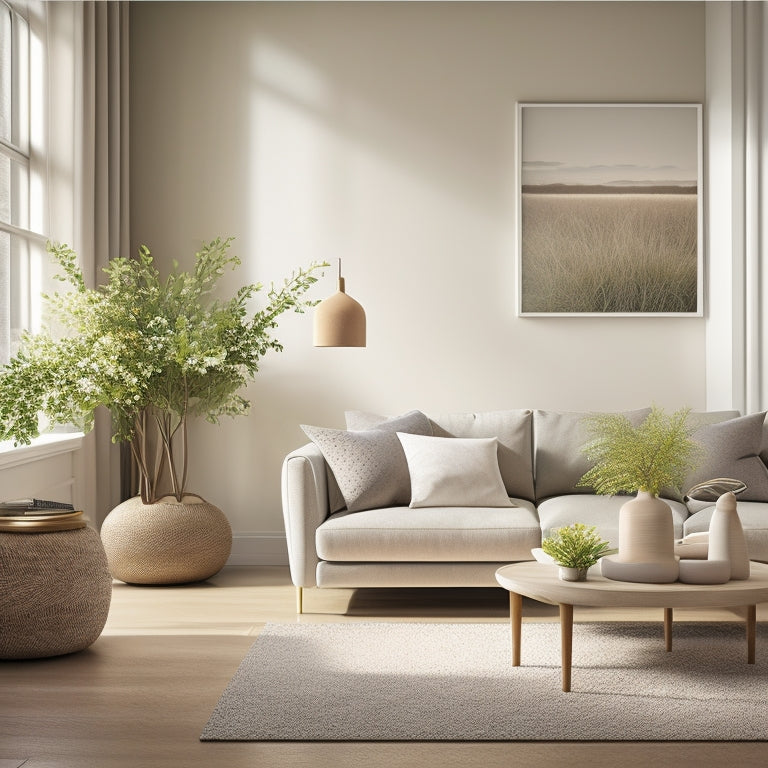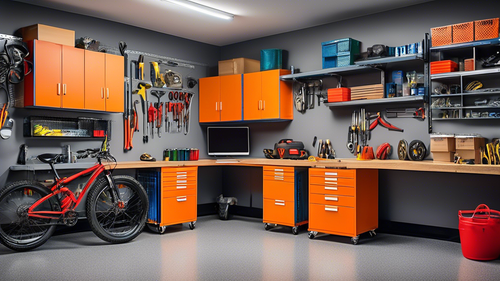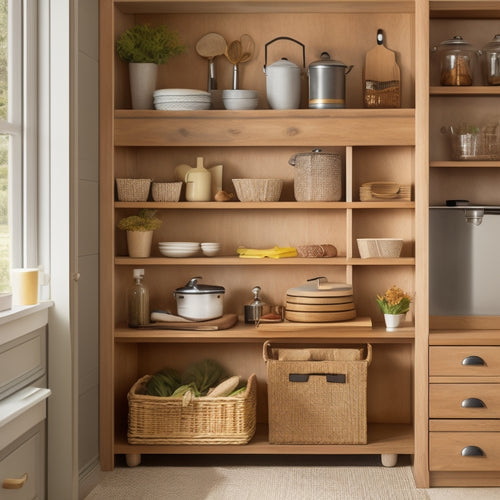
Why a Simplified Home Is a Happier Home
Share
By simplifying your home, you're taking the first step towards a happier you. Clutter and disorganization can weigh heavily on your mental and emotional well-being, but by making small, consistent changes, you can create a more peaceful and organized space. Start by decluttering and assigning a home for everything, then employ vertical storage spaces and establish a morning routine to set a positive tone for the day. Implement the one-touch rule to save time and energy, and schedule regular maintenance to stay on top of tasks. As you work towards a more simplified home, you'll find that the benefits extend far beyond your living space - and that's just the beginning of your expedition.
Key Takeaways
- A simplified home reduces feelings of overwhelm and anxiety by creating a sense of control and clarity.
- By decluttering and organizing, individuals can focus on what truly adds value to their lives, promoting a sense of happiness.
- A well-maintained home fosters a sense of accomplishment and pride, leading to increased happiness and self-esteem.
- Simplifying one's living space allows for more free time and energy to pursue activities that bring joy and fulfillment.
- A clutter-free environment improves mental and physical well-being, leading to a happier and healthier home.
Start Small and Be Consistent
Your expedition to a simplified home begins with a single step: committing to start small and be consistent. This mindset shift is vital, as it allows you to build mindful habits that will serve as the foundation for gradual changes.
Don't try to tackle everything at once; instead, focus on making one or two adjustments each week. By implementing a system like HomeID, which centralizes essential documents and contacts, you'll be able to free up time and energy to focus on significant life aspects.
This approach will help you create a sense of control and momentum, motivating you to continue simplifying your space. By starting small, you'll be able to identify what works and what doesn't, allowing you to refine your approach and make sustainable progress towards a more organized and peaceful living environment.
Declutter Before You Organize
Now that you've established a rhythm of small, consistent changes, it's time to tackle the clutter that's holding you back.
It's vital to declutter before you organize, as it allows you to focus on what's truly important to you. This process is an essential step in embracing mindful minimalism, where you intentionally surround yourself with only what adds value to your life.
Think about the last time you:
- Opened a drawer and felt overwhelmed by the mess
- Spent hours searching for a lost item in a sea of clutter
- Felt guilty about getting rid of a gift from a loved one, despite not using it
- Moved clutter from one area to another, without actually addressing the root issue
Assign a Home for Everything
Clutter-free spaces rely on an essential foundation: everything has its designated spot. This means that you need to assign a home for everything, from kitchen utensils to cleaning supplies.
Create designated zones for specific items, like a reading nook or a homework station. This will help you maintain order and make it easier to find what you need when you need it.
Invest in storage solutions that fit your needs, such as bins, baskets, or shelves. Label each storage unit so you can quickly identify what's inside.
Utilize Vertical Storage Spaces
Assigning a home for everything is just the first step in creating a simplified home. Now it's time to think vertically. You can free up floor and surface space by utilizing wall mounted solutions and vertical shelving. This won't only make your space feel more open, but it'll also keep your belongings organized and easily accessible.
-
Imagine a pegboard in your entryway, holding your keys, bags, and jackets.
-
Depict a floor-to-ceiling bookshelf in your living room, storing your favorite novels and decorative items.
-
Envision a wall-mounted desk in your home office, providing a clutter-free workspace.
- Visualize a set of vertical shelves in your kitchen, storing your cookbooks, spices, and infrequently used appliances.
Create a Morning Routine
How do you start your day? Do you hit the snooze button repeatedly, or do you spring out of bed feeling refreshed?
Creating a morning routine can set the tone for a productive and peaceful day. Start with mindful mornings by dedicating 10-15 minutes to meditation, journaling, or simply enjoying a cup of coffee in silence.
Next, incorporate energizing rituals that get you moving, such as yoga or a short walk. A consistent morning routine helps you feel more in control and focused.
Implement the One-Touch Rule
Your daily routine is filled with tasks, from responding to emails to folding laundry, and it's easy to get bogged down in the process.
By implementing the one-touch rule, you'll save time and energy by handling each task once and moving on. This habit formation technique allows you to focus on the task at hand, rather than revisiting it multiple times.
- You open a letter, you deal with it immediately, and file or toss it.
- You receive an email, you respond or archive it right away.
- You take off your jacket, you hang it up or put it away.
- You finish a meal, you wash the dishes or load the dishwasher.
Schedule Regular Maintenance
You'll need to schedule regular maintenance to keep your home running smoothly.
Start by setting daily task notifications and allocating specific time blocks for tasks like cleaning and organization.
Additionally, plan for seasonal deep cleaning sessions to tackle bigger tasks and keep your home in top condition.
Daily Task Reminders
A well-maintained home requires regular upkeep, and daily task alerts can help guarantee that critical tasks don't fall by the wayside.
You can set up visual prompts and employ digital tools to stay on top of tasks.
This way, you'll never forget to:
- Take out the trash on Thursdays
- Wipe down kitchen counters daily
- Vacuum high-traffic areas weekly
- Check and replace air filters monthly
Set Aside Time Blocks
How do you guarantee that maintenance tasks don't get lost in the shuffle of daily life? By setting aside dedicated time blocks, you ascertain that essential tasks are completed without encroaching on your daily routine.
Schedule regular maintenance slots in your calendar, allocating specific times for tasks like laundry, grocery shopping, or bill payments. This approach enables you to manage your time effectively, prioritize tasks, and maintain a sense of control.
Seasonal Deep Cleaning
Setting aside dedicated time blocks for maintenance tasks is just the beginning. To really stay on top of your space, you need to incorporate seasonal deep cleaning into your routine. This means creating seasonal checklists that tackle specific tasks, like cleaning out your gutters in the fall or inspecting your HVAC system in the spring.
Some tasks to contemplate adding to your seasonal checklists include:
- Dusting and cleaning ceiling fans and air vents
- Power washing your deck or patio
- Inspecting and repairing any torn screens
- Deep cleaning your refrigerator and oven
Frequently Asked Questions
Can I Simplify My Home if I Live With Clutter-Loving Family Members?
Imagine traversing a dense forest, but instead of trees, it's clutter. You can still find a path, even with family members who love clutter. Find common ground through compromise and open family communication to create a simpler, more peaceful space that works for everyone.
How Do I Handle Sentimental Items That Are Hard to Declutter?
You tackle sentimental items by acknowledging your emotional attachment, then preserve memories through photos, journaling, or digitization, allowing you to let go of physical items while maintaining the memories they hold.
Will Simplifying My Home Really Reduce My Stress Levels?
When you cut through the clutter, you'll find yourself cutting loose from stress too; simplifying your home can be a welcome change, bringing mental clarity and reducing stress levels, helping you feel more in control and on top of things.
Can I Simplify My Home on a Very Tight Budget?
You can simplify your home on a tight budget by implementing budget-friendly tips, like repurposing items and DIY decluttering, and minimalist hacks, such as the "one in, one out" rule, to create a more organized and peaceful space.
How Long Does It Take to See the Benefits of a Simplified Home?
You'll start seeing benefits of a simplified home within a few weeks, but it's a gradual process; set realistic timeframe expectations, as it takes 2-6 months to fully adjust and 1-2 years to maintain a clutter-free space.
Related Posts
-

Garage Storage: A Boost to Your Home Value
Making the Most of a Hidden Gem Are you looking to increase your home's value without breaking the bank? Garage st...
-

3 Kitchen Hacks for a Clutter-Free Home
You can achieve a clutter-free kitchen by implementing three simple hacks: clear off countertops by designating spots...
-

7 Creative Corner Cabinet Storage Solutions
You're looking to reveal the full potential of your corner cabinets, and you're not alone - maximizing storage in the...


